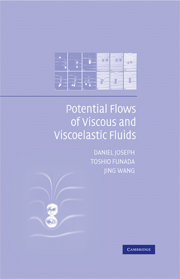Book contents
- Frontmatter
- Contents
- Preface
- List of Abbreviations
- 1 Introduction
- 2 Historical notes
- 3 Boundary conditions for viscous fluids
- 4 Helmholtz decomposition coupling rotational to irrotational flow
- 5 Harmonic functions that give rise to vorticity
- 6 Radial motions of a spherical gas bubble in a viscous liquid
- 7 Rise velocity of a spherical cap bubble
- 8 Ellipsoidal model of the rise of a Taylor bubble in a round tube
- 9 Rayleigh–Taylor instability of viscous fluids
- 10 The force on a cylinder near a wall in viscous potential flows
- 11 Kelvin–Helmholtz instability
- 12 Energy equation for irrotational theories of gas–liquid flow: viscous potential flow, viscous potential flow with pressure correction, and dissipation method
- 13 Rising bubbles
- 14 Purely irrotational theories of the effect of viscosity on the decay of waves
- 15 Irrotational Faraday waves on a viscous fluid
- 16 Stability of a liquid jet into incompressible gases and liquids
- 17 Stress-induced cavitation
- 18 Viscous effects of the irrotational flow outside boundary layers on rigid solids
- 19 Irrotational flows that satisfy the compressible Navier–Stokes equations
- 20 Irrotational flows of viscoelastic fluids
- 21 Purely irrotational theories of stability of viscoelastic fluids
- 22 Numerical methods for irrotational flows of viscous fluid
- Appendix A Equations of motion and strain rates for rotational and irrotational flow in Cartesian, cylindrical, and spherical coordinates
- Appendix B List of frequently used symbols and concepts
- References
- Index
Preface
Published online by Cambridge University Press: 09 October 2009
- Frontmatter
- Contents
- Preface
- List of Abbreviations
- 1 Introduction
- 2 Historical notes
- 3 Boundary conditions for viscous fluids
- 4 Helmholtz decomposition coupling rotational to irrotational flow
- 5 Harmonic functions that give rise to vorticity
- 6 Radial motions of a spherical gas bubble in a viscous liquid
- 7 Rise velocity of a spherical cap bubble
- 8 Ellipsoidal model of the rise of a Taylor bubble in a round tube
- 9 Rayleigh–Taylor instability of viscous fluids
- 10 The force on a cylinder near a wall in viscous potential flows
- 11 Kelvin–Helmholtz instability
- 12 Energy equation for irrotational theories of gas–liquid flow: viscous potential flow, viscous potential flow with pressure correction, and dissipation method
- 13 Rising bubbles
- 14 Purely irrotational theories of the effect of viscosity on the decay of waves
- 15 Irrotational Faraday waves on a viscous fluid
- 16 Stability of a liquid jet into incompressible gases and liquids
- 17 Stress-induced cavitation
- 18 Viscous effects of the irrotational flow outside boundary layers on rigid solids
- 19 Irrotational flows that satisfy the compressible Navier–Stokes equations
- 20 Irrotational flows of viscoelastic fluids
- 21 Purely irrotational theories of stability of viscoelastic fluids
- 22 Numerical methods for irrotational flows of viscous fluid
- Appendix A Equations of motion and strain rates for rotational and irrotational flow in Cartesian, cylindrical, and spherical coordinates
- Appendix B List of frequently used symbols and concepts
- References
- Index
Summary
Potential flows of incompressible fluids with constant properties are irrotational solutions of the Navier–Stokes equations that satisfy Laplace's equation. How do these solutions enter into the general problem of viscous fluid mechanics? Under certain conditions, the Helmholtz decomposition says that solutions of the Navier–Stokes equations can be decomposed into a rotational part and an irrotational part satisfying Laplace's equation. The irrotational part is required for satisfying the boundary conditions; in general, the boundary conditions cannot be satisfied by the rotational velocity, and they cannot be satisfied by the irrotational velocity; the rotational and irrotational velocities are both required and they are tightly coupled at the boundary. For example, the no-slip condition for Stokes flow over a sphere cannot be satisfied by the rotational velocity; harmonic functions that satisfy Laplace's equation subject to a Robin boundary condition in which the irrotational normal and tangential velocities enter in equal proportions are required.
The literature that focuses on the computation of layers of vorticity in flows that are elsewhere irrotational describes boundary-layer solutions in the Helmholtz decomposed forms. These kinds of solutions require small viscosity and, in the case of gas–liquid flows, are said to give rise to weak viscous damping. It is true that viscous effects arising from these layers are weak, but the main effects of viscosity in so many of these flows are purely irrotational, and they are not weak.
- Type
- Chapter
- Information
- Potential Flows of Viscous and Viscoelastic Liquids , pp. xv - xviPublisher: Cambridge University PressPrint publication year: 2007

